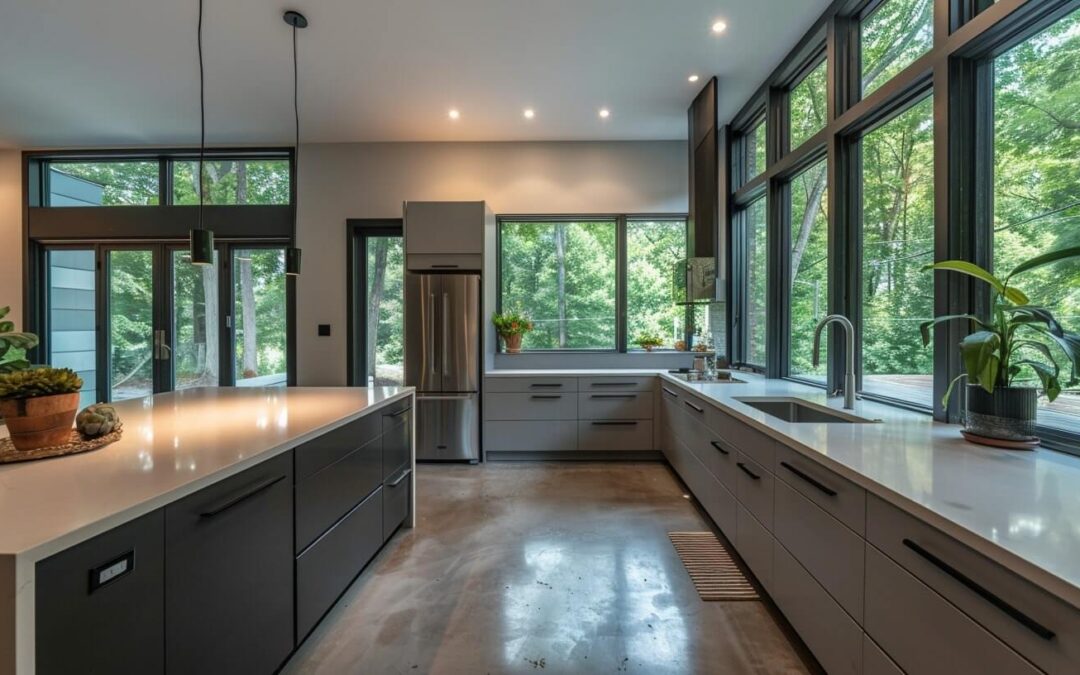When planning your Westchester kitchen remodel, consider how energy efficiency can enhance both your space and your budget. Start by assessing your current energy use to pinpoint areas for improvement. Choosing ENERGY STAR-rated appliances and optimizing your lighting can make a significant difference. Additionally, think about the materials you use and how they contribute to sustainability. You might be surprised by the impact of these choices, but there’s more to explore in terms of insulation and ventilation that could further elevate your kitchen’s efficiency. Let’s take a closer look at those options.
Assess Your Current Energy Use
Before diving into your kitchen remodel, take a moment to assess your current energy use. Start by reviewing your energy bills over the past year to identify patterns and peak usage times.
Consider conducting an energy audit, which can pinpoint inefficiencies like drafts or outdated lighting. Check your appliances’ energy ratings; older models often consume more electricity than necessary.
Don’t forget to evaluate your cooking habits and how they impact energy consumption. For instance, using the oven versus the stovetop can make a difference.
Choose Energy-Efficient Appliances
When it comes to remodeling your kitchen, selecting energy-efficient appliances is crucial for reducing your energy consumption.
Look for appliances with the ENERGY STAR label, as they meet strict efficiency guidelines set by the EPA. These appliances not only save energy but can also lower your utility bills over time.
Consider opting for a refrigerator with a top freezer, as it typically uses less energy than side-by-side models.
Also, think about induction cooktops, which heat faster and waste less energy compared to traditional electric or gas stoves.
Investing in a high-efficiency dishwasher can save water and energy as well.
Optimize Lighting Solutions
After selecting energy-efficient appliances, it’s time to focus on your kitchen’s lighting solutions.
Start by replacing old incandescent bulbs with LED lights, which use up to 80% less energy and last significantly longer. Consider installing dimmer switches to adjust the brightness according to your needs, reducing energy consumption during cooking or entertaining.
Use task lighting, like under-cabinet fixtures, to illuminate work areas without relying on overhead lights. Incorporate natural light by adding larger windows or skylights, which can also enhance the kitchen’s ambiance.
Lastly, choose light fixtures that complement your kitchen’s style while maximizing energy efficiency. With these steps, you’ll create a brighter, more functional space that saves energy and lowers your utility bills.
Improve Insulation and Ventilation
Enhancing your kitchen’s insulation and ventilation not only boosts energy efficiency but also creates a more comfortable cooking environment.
Start by sealing gaps around windows and doors to prevent drafts, which can waste energy. Consider adding insulation to walls and ceilings to maintain a stable temperature. This helps your heating and cooling systems work more efficiently.
Next, improve ventilation by installing a range hood that effectively removes cooking odors and excess heat. Make sure your kitchen is well-ventilated to reduce humidity, which can lead to mold growth.
You might also want to incorporate operable windows for fresh air circulation. These simple upgrades not only enhance your kitchen’s functionality but also contribute to long-term energy savings.
Incorporate Sustainable Materials
Choosing sustainable materials for your kitchen remodel not only benefits the environment but also enhances the overall aesthetic of your space.
Opt for bamboo or reclaimed wood for cabinetry and flooring; these options are durable and eco-friendly. Look for countertops made from recycled glass or sustainable quartz, which offer both style and resilience.
When selecting appliances, choose Energy Star-rated models that consume less energy and reduce utility costs. Sustainable materials often come with low VOC finishes, improving your indoor air quality.
Additionally, consider using natural stone, which is sustainable and adds a timeless appeal to your kitchen.
Frequently Asked Questions
How Can I Reduce Water Usage in My Kitchen Remodel?
To reduce water usage in your kitchen remodel, install low-flow faucets and appliances.
Use efficient dishwashers, and consider rainwater collection systems.
You’ll save water and lower your utility bills while enhancing your kitchen’s sustainability.
What Are the Benefits of Smart Home Technology in the Kitchen?
Smart home technology in your kitchen enhances convenience, efficiency, and security.
You can control appliances remotely, save energy, and simplify meal prep.
Plus, it adds value to your home and improves your overall cooking experience.
How Can I Recycle Old Kitchen Materials During the Remodel?
You can recycle old kitchen materials by donating appliances, repurposing cabinets, and using reclaimed wood.
Local recycling centers might accept metals and plastics.
Check for community programs that promote sustainable practices during your remodel.
Are There Tax Incentives for Energy-Efficient Kitchen Upgrades?
Yes, there are tax incentives for energy-efficient upgrades.
You should check with local government websites or consult a tax professional to find specific programs that apply to your kitchen remodel and maximize your savings.
What Is the Lifespan of Energy-Efficient Appliances Compared to Regular Ones?
Energy-efficient appliances typically last longer than regular ones, often by several years.
You’ll find that their durability, combined with lower energy costs, makes them a smart investment for your home and budget in the long run.
Conclusion
By implementing these energy-efficient strategies in your Westchester kitchen remodel, you can create a space that’s not only stylish but also eco-friendly. Start with an energy audit to pinpoint inefficiencies, then choose ENERGY STAR appliances and upgrade to LED lighting. Don’t forget to improve insulation and ventilation while incorporating sustainable materials. With these thoughtful choices, you’ll reduce energy consumption, save on utility bills, and enjoy a more comfortable kitchen for years to come.

